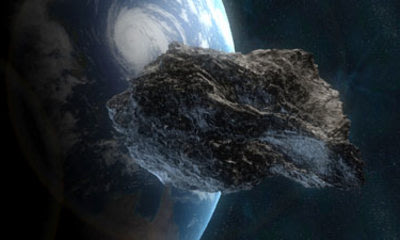Earth's close encounter with an asteroid
Page 1 of 1
 Earth's close encounter with an asteroid
Earth's close encounter with an asteroid
Tumbling Asteroid To Pass Earth Within Hours
By Thomas Moore, science correspondent
Sky News

Tumbling Asteroid To Pass Earth Within Hours
An asteroid bigger than an aircraft carrier will brush past the Earth within the next few hours.
The 400-metre (437-yard) wide asteroid, called 2005 YU55, will speed past the planet at a distance of 201,700 miles - closer than the moon.
It Is our closest encounter with such a large space rock in three decades.
But Marina Brozovic of Nasa said there is no cause for alarm.
"It is not going to hit us," she said.
"We have a good idea of its orbit for the next 100 years and the is no chance of impact."
The asteroid was discovered in April 2010, when observations with the Arecibo radar telescope revealed a fuzzy image of the rock tumbling through space.
Nasa is hoping to take much higher resolution photographs of its dark surface as it passes by at 23.28 GMT time on November 8.
Amateur astronomers will need a six-inch telescope to stand a chance of seeing the asteroid, but have been warned that it is moving so fast that it will be difficult to track.
Nasa has set up a near earth object programme known as Spaceguard to locate the estimated 1,000 asteroids and comets larger than 1km (1,093 yards) in diameter - large enough to cause mass extinction of most life on Earth.
By Thomas Moore, science correspondent
Sky News

Tumbling Asteroid To Pass Earth Within Hours
An asteroid bigger than an aircraft carrier will brush past the Earth within the next few hours.
The 400-metre (437-yard) wide asteroid, called 2005 YU55, will speed past the planet at a distance of 201,700 miles - closer than the moon.
It Is our closest encounter with such a large space rock in three decades.
But Marina Brozovic of Nasa said there is no cause for alarm.
"It is not going to hit us," she said.
"We have a good idea of its orbit for the next 100 years and the is no chance of impact."
The asteroid was discovered in April 2010, when observations with the Arecibo radar telescope revealed a fuzzy image of the rock tumbling through space.
Nasa is hoping to take much higher resolution photographs of its dark surface as it passes by at 23.28 GMT time on November 8.
Amateur astronomers will need a six-inch telescope to stand a chance of seeing the asteroid, but have been warned that it is moving so fast that it will be difficult to track.
Nasa has set up a near earth object programme known as Spaceguard to locate the estimated 1,000 asteroids and comets larger than 1km (1,093 yards) in diameter - large enough to cause mass extinction of most life on Earth.

eddie- The Gap Minder
- Posts : 7840
Join date : 2011-04-11
Age : 68
Location : Desert Island
Page 1 of 1
Permissions in this forum:
You cannot reply to topics in this forum

